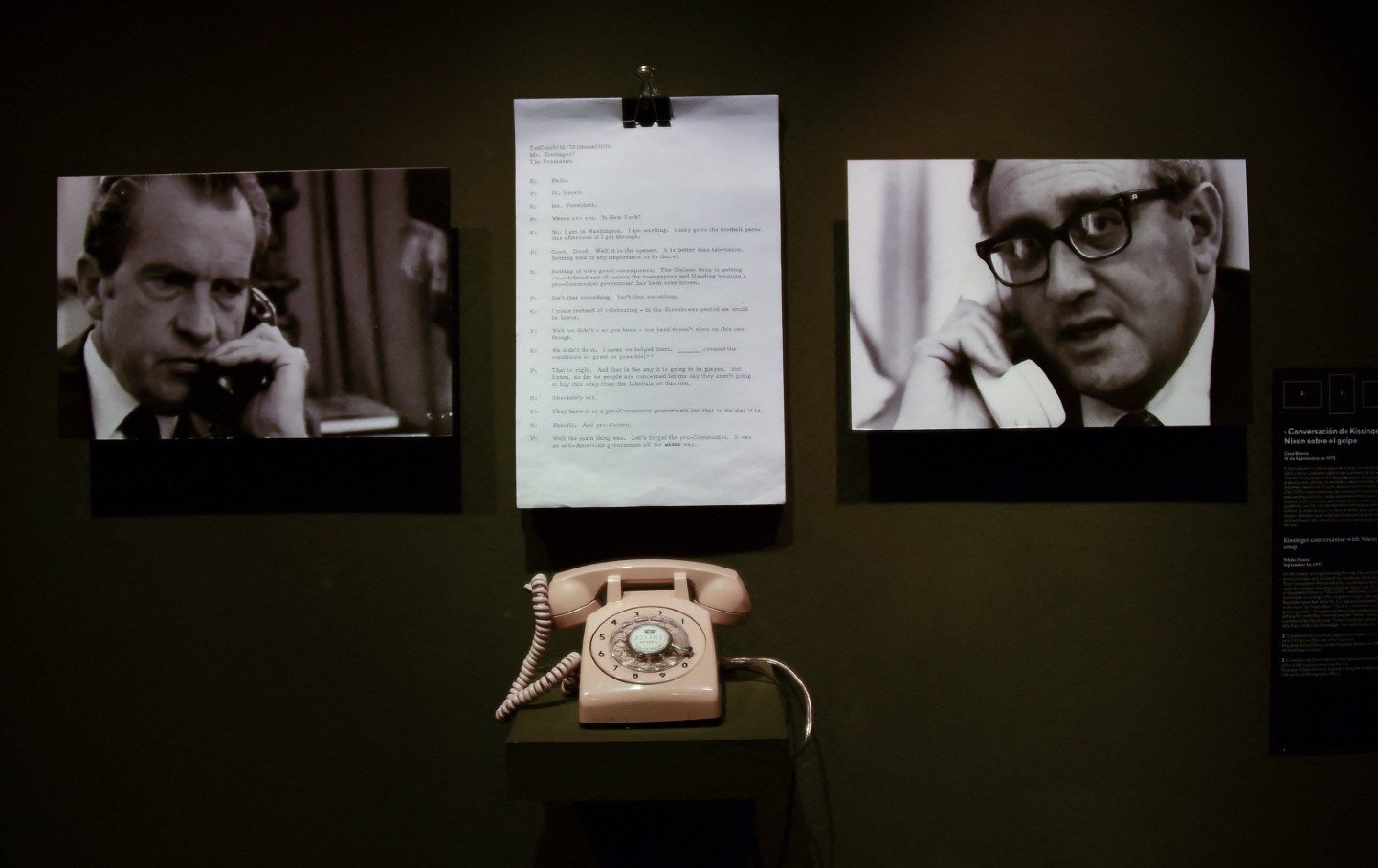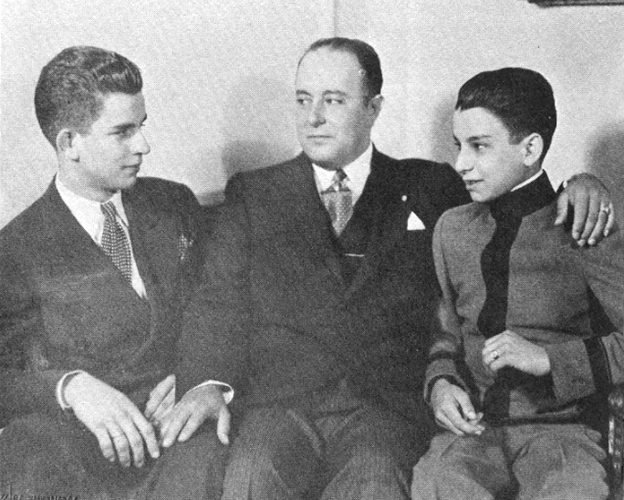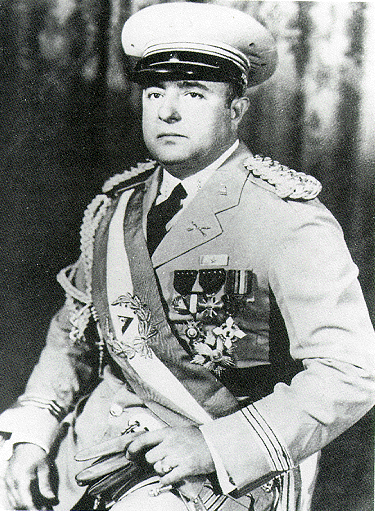Latin America
Related: About this forumChile: The Secrets the US Government Continues to Hide
AUGUST 31, 2023
Fifty years after the military coup that brought down Salvador Allende and installed the Pinochet dicatorship, there are still top secret documents on the US role that must be declassified.
PETER KORNBLUH

Photographs of former President Richard Nixon and former Secretary of State Henry Kissinger displayed during “Secrets of State: The Declassified History of the Chilean Dictatorship,” an exhibition at the Museum of Memory and Human Rights in Santiago, Chile in 2017.
(Martin Bernetti / AFP via Getty)
On August 25, the Central Intelligence Agency quietly posted on its website two documents on the military coup in Chile that had been kept top secret for half a century: the President’s Daily Brief (PDB) for the morning of the September 11, 1973—the day of the coup—and for September 8, 1973, as the Chilean military finalized its plans to overthrow the democratically elected government of Socialist Salvador Allende. The newly released documents proved almost impossible to find and read on the CIA website, buried among dozens of other previously declassified PDBs. Eventually, the State Department sent out a press advisory providing the links. The release of the PDBs was “in accordance with our commitment to increased transparency,” according to the press release. “We remain committed to working with our Chilean partners to try and identify additional sources of information to increase our awareness of impactful events throughout our shared history.”
As the 50th anniversary of the coup approaches, that commitment will be tested as Chileans, and their government, seek to obtain additional classified documents on the US role in undermining democracy and supporting dictatorship in Chile. This week a delegation of Chilean congressional representatives from the Socialist Party met with US Ambassador Bernadette Meehan to lobby her for release of the remaining secret records on Chile; earlier this month, the Chilean Congress voted almost unanimously to request that the Foreign Ministry solicit still-secret records on US “intervention in Chile’s sovereignty before, during and after the coup of 1973.” And the Chilean government of Gabriel Boric has already appealed to the Biden administration for a special, 50th-anniversary gesture of declassification diplomacy. “We still don’t know what President Nixon saw on his desk the morning of the military coup,” as Chile’s ambassador to Washington, Juan Gabriel Valdés, stated in an interview before the PDBs were released. “There are details that remain of interest to [Chileans], that are important for us to reconstruct our own history.”
Censored History
Among the documents on President Nixon’s desk on the morning of September 11, 1973, was the PDB—a daily CIA intelligence summary that contained three paragraphs on the opening salvos of the military coup in Chile. Fifty years after Nixon read it, we finally know what it says—very little. The intelligence provided to the president on the initiation of the coup was equivocal and erroneous. “Although military officers are increasingly determined to restore political and economic order, they may still lack an effectively coordinated plan that could capitalize on the widespread civilian opposition,” the PDB advised, incorrectly. “President Allende, for his part,” the PDB stated more accurately, “still hopes that temporizing will fend off a showdown.”
But Nixon had access to far more detailed and dramatic intelligence. A special CIA “CRITIC”—Critical Advance Intelligence Cable—that would have been distributed on an urgent basis to the highest levels of the White House on September 10, provided concrete reporting on the date, time, and place of the planned coup; another top secret CIA memo that reached the White House the morning of September 11 contained an urgent request from “a key officer in the military group planning overthrow President Allende” who asked “if the U.S. Government would come to the aid of the Chilean military if the situation became difficult.” How the president of the United States responded to that request is one of the details of the history of the coup that remain unknown.
More:
https://www.thenation.com/article/world/chile-coup-classified-documents/
Alexander Of Assyria
(7,839 posts)Direct and deep secret support of military coups and against democracy is more efficient though, such quick results…so corporations can get back to exploitation without too much damage to the stock price.
American history has a lot of secrets still buried along with the missing bodies.
brush
(57,510 posts)during Ortega's earlier reign.
Ortega has long since returned to power and is going through some things himself. It's complicated.
Judi Lynn
(162,384 posts)guy, a truly nasty, obnoxious, snotty man, who spoke openly of the fact they put mines in the water in Nicaragua, and I was stunned by the fact he seemed to have absolutely no conscience at all. He was just as cold, and aggressive as anyone might expect.
It was also the first time I'd ever heard they mined a harbor, an evil act which had been done to death already!
I decided to take a quick google check and saw it mentioned in this Wikipedia entry, with a lot more useful information:
CIA activities in Nicaragua
CIA activities in Nicaragua have been ongoing since the 1980s. The increasing influence gained by the Sandinista National Liberation Front, a left-wing and anti-imperialist political party in Nicaragua, led to a sharp decrease in Nicaragua–United States relations, particularly after the Nicaraguan Revolution. In 1981, President Ronald Reagan authorized the Central Intelligence Agency to support the Contras, a right-wing Nicaraguan political group to combat the influence held by the Sandinistas in the Nicaraguan government. Various anti-government rebels in Nicaragua were organized into the Nicaraguan Democratic Force, the first Contra group, at the behest of the CIA. The CIA also supplied the Contras with training and equipment, including materials related to torture and assassination. There have also been allegations that the CIA engaged in drug trafficking in Nicaragua.
. . .
The United States saw the Sandinistas as Communists, and felt the need to stop them. Congress viewed the Reagan Administration's anti-Sandinista policies with extreme skepticism, and were under the impression that the true goal of the CIA operation in Nicaragua was to overthrow the Sandinista government. Congress' efforts resulted in passage of an amendment in late 1982 introduced by Representative Edward P. Boland to the Fiscal Year 1983 Defense Appropriations bill. This is the first of a series of Boland Amendments prohibiting the CIA, principal conduit of covert American support to the Contras, from spending any money "for the purpose of overthrowing the government of Nicaragua".[9] The CIA, however, interpreted the "purpose" stated in this phrase as the purpose of the CIA rather than the purpose of the end user. Thus, the CIA argued that since the purpose of the CIA was not to overthrow the government, that the money and military assistance went to people who had this goal did not matter.[10] The subsequent lack of change in the Nicaragua operation significantly contributed to the eventual further restrictions imposed by Congress in the second version of the Boland amendment.[7]
The majority report stated, "The Central Intelligence Agency was the U.S. Government agency that assisted the contras. In accordance with Presidential decisions, known as findings, and with funds appropriated by Congress, the C.I.A. armed, clothed, fed and supervised the contras. Despite this assistance, the contras failed to win widespread popular support of military victories within Nicaragua."[11]
. . .
The CIA carried out the Nicaraguan operation based on military intelligence indicating the Sandinista government had close ties to the Cuban and Soviet governments, which represented a strategic threat to the U.S.[6] U.S. policy planners also feared that the success of democracy and socialism in Nicaragua would inspire revolutions across the continent, thereby challenging U.S. hegemony and the interests of Western corporations. At this time, the Sandinistas were building their military to a level that was disproportionate for the size of Nicaragua; the U.S. saw this as a Soviet-backed push for power in the region.[6] The CIA gave $50,000 (equivalent to $161,000 in 2022) to the training and arming of the Contras in 1981, which was eventually followed up by millions more once the CIA secured funding for the operation. The CIA executed operations of their own: in 1982, a CIA-trained team blew up two bridges in Nicaragua and mined Corinto harbor, which may have been carried out by members of the U.S. military rather than through the indigenous assets the CIA claimed it used. The mines were an attempt to disrupt the Nicaraguan economy by closing down the main shipping port. Petroleum imports and cotton exports were the main targets.[7] The mines they eventually used were specifically designed to only cause a large noise rather than actually damage ships. The logic behind this is that once a harbor was known to be mined, it would be flagged as such and therefore avoided by most shipping companies. This eventually backfired and became somewhat of a self-fulfilling prophecy for the U.S. as this act actually drove the Sandinista government closer to the Soviet Union because it needed petroleum imports.[7]
More:
https://en.wikipedia.org/wiki/CIA_activities_in_Nicaragua
Judi Lynn
(162,384 posts)which only a revolution could remove.
Here's a quick grab which looks useful. It crams a lot of information into one article, and after you've read it, if you didn't know anything about the 40+ years of hell the Samozas put Nicaraguans through, you definitely will realize why a revolution was unavoidable. The people couldn't live another day under this deadly regime:
The Deaths of Somoza
May 2007 WLT
Don’t think I believe the people erected this statue to me
because I know better than you that I commissioned it myself.
Nor do I pretend to pass into posterity with it
because I know the people will tear it down someday.
Nor do I wish to give myself in life
a monument you would never raise to me in death:
I erected this statue because I knew you would hate it.
—Ernesto Cardenal, “Somoza Unveils the Statue of
Somoza in Somoza Stadium”
Three Somozas ruled Nicaragua in the twentieth century, each a dark persona magnified and diminished by personal infamies and self‑interests that crushed their small, immensely complex nation into a mass of social, economic, and political wreckage it is still sorting out. During a familial succession unique in Latin America, backed by the gangster-like National Guard (Guardia Nacional), essentially a private army, plus dependable financial and military support from the U.S. government, the triad dominated Nicaragua from 1936 to 1979, monopolizing nearly every industry and natural resource in the country, from railroads to the skin trade, while looting it from the peaks of its volcanoes to the dirt floors of its poorest farmers. Only a deep‑rooted, relentless spirit of survival and resistance native to its citizens kept the country (the largest but poorest in Central America) from being swallowed whole.
The Somozas survive in triple vision (a sort of historical triplopia), brought into focus through tales of their rise to power, shared incidents in their overlapping lives, and narratives attempting to disentangle the interconnected nightmares they wrought. Among the most engaging examples of the last is Death of Somoza, by Nicaraguan-Salvadoran poet Claribel Alegría and her husband, writer Darwin Flakoll, a grim but colorful account of the third Somoza’s 1980 assassination in Asunción, Paraguay by a covert squad of Argentine revolutionaries following the triumph of the Nicaraguan revolution.
One of many Alegría‑Flakoll collaborations (which include fiction, nonfiction, and translations), the account is a cross‑genre tour de force that weaves a mesmerizing chronicle from fact, informed speculation, historical documentation, and interviews with participants in the operation. Challenged by subject matter with potential to lapse into rhetoric or political diatribe at any juncture, the authors never allow the story to become superficial or strained, balancing their resources for the sake of a credibility. Ostensibly centered on a particular episode and individual, Anastasio Somoza Debayle (Somoza III), the work incorporates a wide range of background information, including startling details about clandestine operations.
The interviews begin with “Ramón,” commander of the seven‑member squad (four men and three women), revealed to be Enrique Haroldo Gorriarán Merlo, a founder and prominent leader of Argentina’s People’s Revolutionary Army (erp). The book then switches back and forth between his memories and those of other squad members, linked and framed by historical context, capturing the political and social moods of the period with lively energy drawn from the power and drama of the last phase of Nicaragua’s forced, macabre dance with the treacherous family that held it in a death grip for over four decades.
More:
https://www.worldliteraturetoday.org/deaths-somoza-george-evans
~ ~ ~
Somoza dictatorship, facts, photos, well arranged collection:
The Somoza Dynasty


Anastasia Somoza Garcia
(1st Somoza "President" )
https://www.latinamericanstudies.org/somoza.htm
brush
(57,510 posts)And do you have to pay extra for the medals, ribbons and braids?
Alexander Of Assyria
(7,839 posts)Niger military led coup, removing a democratically elected government…then thinking sometimes it’s not ok at all. Egypt, Thailand, etc. etc.
Tipsy turfy world of power hungry men.
brush
(57,510 posts)arms/cocaine intersection. The CIA continues to meddle.
There's still uncertainly in what the agency had to do with reporter Gary Webb's death as he broke the story on the Contra-cocaine link to the drug traffic in California.
Judi Lynn
(162,384 posts)I wonder if they felt they couldn't afford not to make an example of him, too. . . .
Sounds a little Putinish, looking back now.
What a horrible shame. Looks as if the "law can't touch 'em."

Martin68
(24,611 posts)government that had democratic elections unbroken from 1925 to 1973. Then the "we just want to protect democracy" US fiddled with Chile's economy and interfered deeply in their politics to aid a coup to overthrow President Allende because he was a socialist. A coup during which he was shot and killed.